Innovation of any kind (for example, a community group needing to change their funding model) implies that there will be some change. For change to occur, there is necessarily a period of uncertainty where we ask ourselves, ‘what will the future look like for us?’. It is often followed by doubt: ‘Will this even work?’ Ambiguity is the fear, doubt and uncertainty we experience in the process of designing something new.
In the work of regional innovation, comfort with ambiguity is needed to effectively guide groups through the grey area and towards new futures.
The ideas and stories captured here were shared by members of the Regional Innovators Network (RIN) during a peer learning session on 19 February 2019. The Network discussed various frameworks which leaders can draw upon when working with ambiguity.
Quick Summary
What does it mean?
- Uncertainty, discomfort, frustration and fear
- Leadership towards an uncertain outcome
- Growth (out of the fishbowl and into the pond)
- The Grey Zone of opportunity…The Bridges Model of Transition.
What helps?
- Managing yourself: Self awareness
- Supporting others to work with ambiguity: Holding space
- Framework 1: The Cynefin Framework
- Framework 2: Don’t ignore the ‘groan zone’
- Acknowledging people’s feelings
- Pause. Step back. Establish coherence. Continue.
- Visual note-taking, scenario building and card sorting
What hinders?
- Negative framing
- Having clear-cut expectations about outcomes
- Allowing frustration to linger in the room un-addressed
- Sowing doubt: Instead, build confidence without having the answers
What does it mean?
Uncertainty, discomfort, frustration and fear
When doing the work of regional innovation and community development, we tend to want to arrive at a sense of ‘order’. But being in a mindset of comfort and ‘business as usual’ makes it very difficult to move into innovation or co-design. Ambiguity is the space between the current state of ‘order’ and a preferred state of ‘order’. But how deep in discomfort do we need to be before we know we are growing?
“The organisations we work with often say, ‘We’ve been doing it this way for 20 years, if we change now we might not get our funding.’ I think there’s fear of change sometimes.” – Annette
Leadership towards an uncertain outcome
Leading through ambiguity requires flexible, adaptive leadership. Top down change management approaches often used in corporate organisations do not necessarily work when we’re trying to create change in communities. Command-and-control, hierarchical leadership styles do not work either. Communities are complex, with many different agendas at play. Leadership through ambiguity is about creating safe ways people can explore possibilities and try new things without knowing what the outcome will be. It requires energising people, helping them find hope. It requires tolerance and diversity. It requires many strategies, many people. It is built on relationships and connection.
Growth (out of the fishbowl and into the pond)
RIN members used analogies to describe the feeling of working with ambiguity:
- It’s like a fish being moved from the fishbowl to the pond. A fish is only going to grow to a certain size in a bowl. A pond brings new opportunities but also new threats and danger that come with the unknown territory.
- It’s like building the plane as we go. We need to do the work even though we are uncomfortable or scared; learn to trust the process, collaborate with others and be open to changing tack quickly.
- It’s a new journey. You step out on the road, willing to take a chance, willing to participate on a journey but you don’t know what’s coming and you don’t know where you might end up. It’s about being ok with not knowing what the future is going to hold.
The Grey Zone of opportunity…The Bridges Model of Transition
When individuals and groups undertake an innovation journey or begin a change, they go through a mental and emotional journey. The William Bridges ‘Transition Model’ helps explain this journey so that we can understand how to help people navigate this journey. The Bridges model has three stages: 1) Ending, Losing & Letting Go 2) The Neutral Zone and 3) The New Beginning.
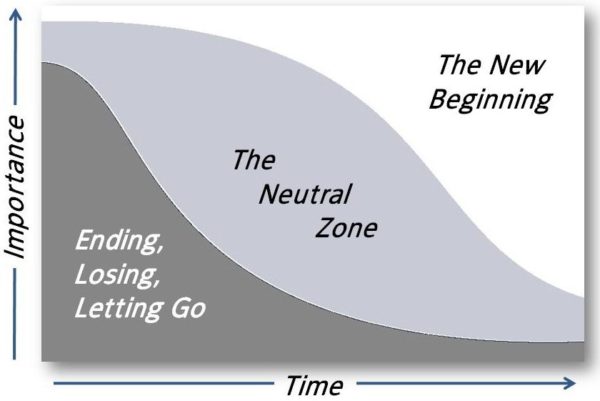
In the first stage the model acknowledges that to make a change, which we may want to celebrate, counterintuitively we experience grief: we experience an ending, losing and letting go – potentially even of our own identity or parts of ourselves.
In The Neutral Zone, we have stepped into a grey, unknown space – the space of ambiguity. The future may be a goal on the horizon, but what it looks like is not clear yet. This grey space is an opportunity to explore possibilities and reimagine ourselves, our roles, our communities. This is a great space for co-design and innovation because they give us a structured way to explore and test our ideas.
The New Beginning is the stage when the future becomes clearer and more real, it crystallises into our reality. In this stage it is important to reinforce the changes that have been made in many different ways so that they will stick.
“How do we support groups through ambiguity in order for new futures to be possible?” – Michelle
What helps
Managing yourself: Self awareness
The first aspect of working with ambiguity is managing yourself. Recognising that you are in a space of ambiguity and cultivating a positive attitude towards ambiguity will help you stay grounded. This requires drawing on your personal resilience to create a positive out of what may seem to be a negative. Here are a number of ways you can help yourself work with ambiguity:
- Notice – observe ourselves – self awareness. Understand your own tolerance and reactions
- Breathe
- Step away
- Write & reflect
- Patience
- Manage your inner control freak. Let’s face it – we all like to be in control. …
- Let go of the complete picture. Sometimes in life we simply cannot have all the information straight away
- Don’t waffle. Make a decision, take action
- Be agile
- Be confident in yourself
- Avoid crystal ball gazing
- Learn stress reduction techniques
- Practise mindfulness
- Be crystal clear on what is clear
- Know what you collectively know and what you don’t
- Encourage risk taking
- Envision alternative scenarios
- Engage other people and perspectives
Supporting others to work with ambiguity: Holding space
If you are working with a group or within your community, working through ambiguity and uncertainty can be confronting. It will be important to create conditions that help people to work with ambiguity.
RIN participants found it helpful to ‘stack the table’ with at least a few people who have energy and positivity about ambiguity to encourage others in the room. With this technique, setting the conditions involved building some excitement around the session beforehand. With people ready to work with ambiguity, you will then need to keep creating structure, processes and an environment that supports people to explore the grey spaces.
“It’s all in the planning, allowing people to go into ambiguity safely. In our session, there wasn’t comfort at the table, people were uncertain, but the way we set it up was to allow people to share what they wanted to share, and reach a place of trust.” – Shane
When you are with a group, it is important to do what facilitators call ‘holding space’. Holding space is an intentional practice of creating a safe space (literally and figuratively) in which people can be vulnerable, where their perspectives and feelings can be witnessed without judgement, and where alternatives can be explored. It involves being fully present with and respecting others, while being fully present with and respecting yourself. It is important at all times with a group, and it is particularly important when working with ambiguity and uncertainty, as well as when dealing with topics and situations that people hold strong feelings about.
In this process, you observe people’s energy and create a space where the group can talk through what they’re sensing. It will be important to help people to surface how they are feeling and work through any emotions that might come. It is also important to close a delicate conversation well and respectfully, and to find a way to transform the feelings into a positive and constructive way forward.
In the following clip, Kristy explains the value of managing our own confidence as leaders.
As leaders, it’s our job to hold the space because different People have different tolerances for the amount of tension they are able to experience.
It can be helpful to set challenges and work with creative tension to motivate people. The frameworks listed below are examples of how you can do this.
Framework 1: The Cynefin Framework
The Cynefin Framework is a model that helps us diagnose the situation we are in — so that we can work out what actions we might take. The strategies we use to get out of ambiguity may be different depending on what type of ambiguity or complexity our group is experiencing.
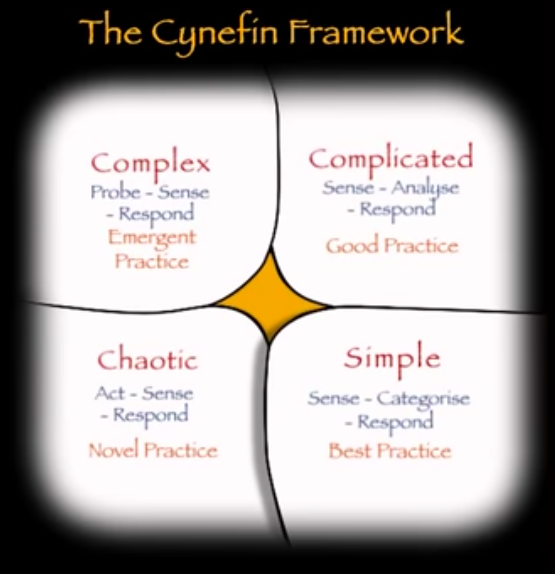
Definitions of each ‘domain’ in the Cynefin model:
- Complex: Cause and effect are only coherent in retrospect and may not repeat. Problem solving or designing in a community is complex because we can’t always predict the outcomes of co-design, reactions of people or potential flow-on effects. Observing and testing can be useful.
- Complicated: Factors are ‘knowable’. Care needs to be taken, however predicting outcomes tends to be easier than with a complex domain.
- Chaotic: Impossible to perceive a relationship between cause and effect. These may be situations of crisis which require immediate action first to stabilise the situation, and only then can the situation be investigated and understood.
- Simple: The relationship between cause and effect is clear. Management approaches that come from organisations or within businesses tend to be suited to complicated and simple situations where cause and effect are predictable.
What kind of situation are you in?
Framework 2: Don’t ignore the ‘groan zone’
Understanding the dynamics of group decision making can help to manage ambiguity. The Groan Zone model points out that when we diverge and before we are able to converge, groups tend to go through an awkward and painful period of discomfort. When you sense that stakeholders are stressed, it can be helpful to name that you have reached ‘the Groan Zone’. This is a time frame with groups may have reached their tolerance level for ambiguity and may start to lose interest and concentration. Keep them engaged and interested by helping them see how they are tracking in the co-design process can help. It is also important to simultaneously build the ability to sit with the discomfort of not having the solution and not having made a decision. Introducing ‘the Groan Zone’ can normalise the discomfort of ambiguity and create a source of hope.
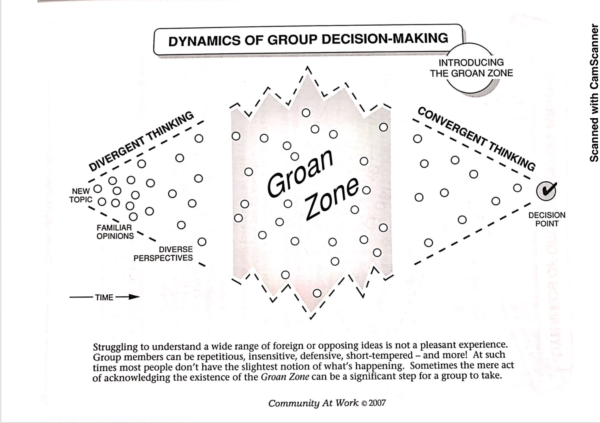
Acknowledging people’s feelings
When you sense that people are struggling to deal with ambiguity and uncertainty, identify the frustration in the room. Help a group notice their own dynamics. Reassure the group that this discomfort and frustration is normal and necessary when working through ambiguity.
In the following video, Michelle explains the value of acknowledging how people are feeling:
Ok, we’ve acknowledged the discomfort. Now what do we do?
Pause. Step back. Establish coherence. Continue.
When you’re in the Groan Zone, you can use the ‘system coherence’ model (below) to help you create coherence so that the group can find their way forward. Coherence – the force that keeps people sticking together – is what helps a group keep working through ambiguity and uncertainty. There are four types of coherence that you are looking to create:
- Establish directional coherence – Where have we been, where are we now, and what is it we are setting out to do?
- Nurture relational coherence – In our relationships, look to our people, our connections, our network of human resources and the team we have available. Are our relationships strong? What can we influence?
- Keep tracking contextual coherence – What’s happening in our context? Revisit the broader environmental context and factors, things that will support or challenge. Have new key external stakeholders emerged? Are there dynamics at play that are impacting us but beyond our influence? Do our approaches make sense within our context?
- Re-establish task coherence – What needs to be true in order to make this happen? What do we need to learn, understand, or test? Where are we in the process? What can we start doing now?
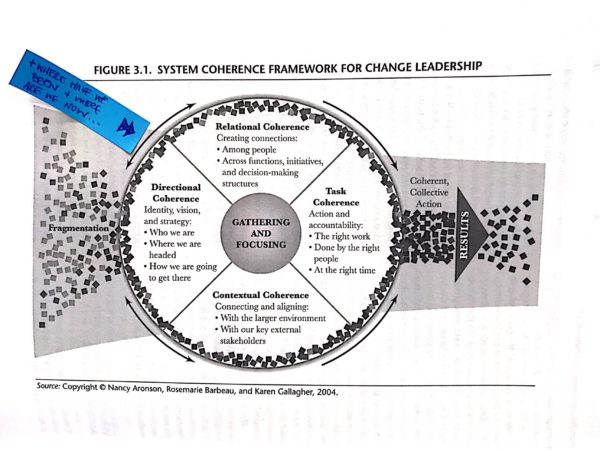
Visual notetaking, scenario building and card sorting
When working with groups, there are some activities/methods that can help you move through the groan zone, including:
- Visual notetaking (like whiteboarding and using butchers paper or flip charts) to externalise people’s ideas, mental models and frustrations. This helps to clarify what we’re saying, let go of our attachment to our own ideas and to neutralise emotions.
- Scenario building can help make possibilities tangible so that a group can compare scenarios, better articulate what they want to happen and begin to formulate a sense of what will (and won’t) work.
- Generative tools like the Group Works card deck (see example below). The Group Works cards name the conditions a group may need in order to work together. The cards can be helpful when designing conversations. The cards can also help a group name what they need at a given moment in time. Place the cards in front of people in the session and invite them to choose what THEY need to move through ambiguity. This may also help people identify what they otherwise may have trouble putting into words. The cards can help people articulate this safely, and can help the group move through difficult or frustrating feelings.
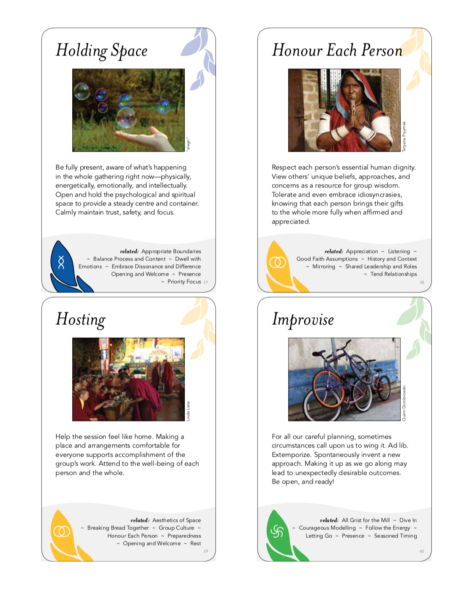
(The image above in an example of four cards in the Group Works Card Deck. The full resource is available via a link at the bottom of this page.)
What hinders?
Negative framing
Be careful and strategic about the design challenge you are posing to your group. For example, a community group facing funding cuts and entering a period of uncertainty and ambiguity about where funding will come from my have a negative perspective. With negative framing, the conversation in this group may be: ‘Let’s discuss whether or not this work matters anymore.’ Whereas positive framing may be: ‘This work matters. How do we see our roles and the role of our work progressing into the future?’
Having clear-cut expectations about outcomes
When working with ambiguity, you cannot be sure of the outcomes. It is important to acknowledge that an initiative has many possible outcomes. Maybe it won’t go the way you expected but you need to be willing to flow with whatever eventuates.
“Every time you undertake a co-design process you learn how to manage ambiguity better, and you learn more about yourself and the people around you. And if it doesn’t work, you can always have a break and regroup and try again.” – Kristy
Allowing frustration to linger in the room un-addressed
Part of our role as leaders is to provide a balance between comfort and discomfort during the ambiguous stages of co-design. Being in the grey stretches people to grow, however sitting in discomfort for too long can tip the balance to negativity, frustration and stagnation as people lose faith in the process. Eventually, your stakeholders do want to reach an outcome and achieve a sense of accomplishment. It is important to share the small wins, celebrate the signals of change and keep fostering the sense of hope.
Sowing doubt: Instead, build confidence without having the answers
Confidence breeds confidence, and doubt is infectious. Our attitude is critical. But when working with ambiguity, it is not possible to be confident in the solutions or the outcome.
It’s important to convey confidence – but the type of confidence is very important. To work with ambiguity, it is important to believe in people, to help others trust the process, to show faith that we can have our differences and find a way through, and to help others find their own confidence.
“If you’re comfortable in yourself and confident, that will be reflected in any engagement you have with someone, and that will give them the confidence to do it too. If you’re going into the grey and into ambiguity, and you’re still ok, even though you don’t know the outcome, people will be able to sense that and might feel the same way. A positive attitude towards ambiguity from the start creates better conditions for your project.” – Kristy
Frameworks links
0 – Cynefin framework
https://www.dropbox.com/s/6dfq6x2rttt8luo/0%20-%20Cynefin%20framework.png?dl=0
1 – Introducing the Groan Zone
https://www.dropbox.com/s/abeo684amcp4o9x/1%20-%20Introducing%20the%20Groan%20Zone.pdf?dl=0
=
2 – Acknowledging feelings + Introducing group dynamics
3 – System coherence framework
https://www.dropbox.com/s/1iu6abp30ceapls/3%20-%20System%20coherence%20framework.jpg?dl=0
Group Works Card Deck
https://www.dropbox.com/s/gk523zrq3nza5sk/Group-Works-Deck-2015-free-download.pdf?dl=0


